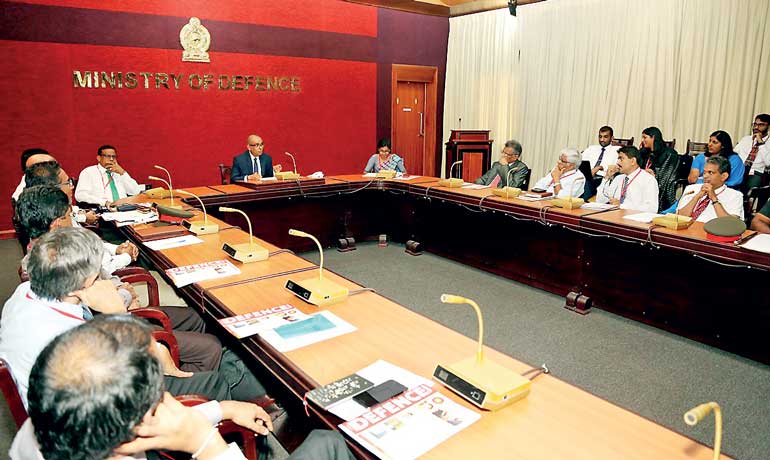Wednesday May 08, 2024
Wednesday May 08, 2024
Tuesday, 6 February 2018 00:00 - - {{hitsCtrl.values.hits}}


Recent statistics released by the Disaster Management Centre indicate that nearly 900,000 people in the north-central and eastern parts of the country have faced serious food insecurity issues in 2016 due to the island’s worst drought in 40 years. This situation was further worsened by severe floods in May 2017 in the south western parts of the country – Pic by Shehan Gunasekara
The Institute of National Security Studies Sri Lanka (INSSSL) hosted a ‘Threat Lens’ roundtable discussion on the topic of ‘Meeting the Challenges and Ensuring Food Security in Sri Lanka’ on 23 January at the Ministry of Defence.
The program was conducted with the aim of organising a discussion in which to propose sustainable mechanisms to ensure food security in Sri Lanka by using inputs from different stakeholders in food cultivation and agrarian research and development work at the policy making level.
The discussion was chaired by R.M.S. Sarath Kumara, Additional Secretary of Defence. It was attended by the Secretary to the Ministry of Agriculture B. Wijayarathne, who in his remarks advocated a fresh outlook on the effects of climate change, the need for high technological cultivation as well as an improved system of water management.
In addition, there was participation of several experts from private and Government organisations, including military institutions, involved in the area of food security as well as the Advisory Council members of INSSSL.
The researchers of INSSSL presented facts and statistics in regard to the challenges of food security in Sri Lanka. Recent statistics released by the Disaster Management Centre indicate that nearly 900,000 people in the north-central and eastern parts of the country have faced serious food insecurity issues in 2016 due to the island’s worst drought in 40 years. This situation was further worsened by severe floods in May 2017 in the south western parts of the country.
The Food and Agriculture Organization of the United Nations (FAO) estimates that about 4.7 million people of the 21 million population of Sri Lanka, or over one-fourth of the population, do not have sufficient food to sustain a healthy life. In the case of food production, paddy harvest has decreased since 2015 in ‘Maha Seasons’. Production in 2015 was estimated at 756,000 metric tons (MT) and by 2017 it has decreased to 543,000 MT.
The presenters revealed that the causes of food insecurity in Sri Lanka included adverse weather, chemical usage, destruction of arable land, inefficient farming methods, changes in policies and a host of other opposing reasons. While commending a number of initiatives with the intention of alleviating this challenge, such as the Presidential Task Force on National Food Production and the Waga Sangramaya (Food Drive), the researchers put forth several deliberations and areas of improvement.
Notably, to place greater emphasis on research and development for the creation of weather resistant varieties of food, changing social perceptions to promote farming and agriculture, regional and international cooperation with countries facing similar threats to food security as well as demographic targeted farming: youth and women empowerment. The presentation concluded by advocating the use of indigenous knowledge, the promotion of domestically grown alternative food variants and self-sustaining models.
The engaging and informative discussion that followed, involving the many experts who were present, resulted in the sharing of a considerable volume of information with regard to improvement in the area of food security. One such piece of advice was to refrain from restricting analysis to food productivity, as the concept needs to be viewed from a much broader perspective. Sri Lanka is expected to be more vulnerable to droughts and floods in the future and the agriculture sector needs to more resilient to the adverse effects of climate change.
There was a suggestion to implement mechanisms for farmers to possess immediate access to information on agriculture. One such mechanism was to connect universities and farms with the objective of increasing productivity by means of higher education. The severity of the decreasing nutritional value of food was also discussed. Many experts suggested prioritising raising awareness of the need for a diverse nutritional diet among consumers, especially school children.
Revisiting the recent ban on pesticides was also recommended, given the decline in tea export. There were experts in the view that the decision was redundant as Sri Lanka is in compliance with the Stockholm convention.
Another point for consideration was improving warehouse management. Although there are stocks available, it is imperative to prepare for the threat of scarcity. The decrease in contribution of agriculture to the country’s GDP was also discussed as there is an indication of workers moving away from farming and resulting in an escalation of costs. It was suggested that this could be controlled by investing in technology where the corporate sector could play a significant role.
The discussion drew to a successful conclusion with all participants unanimously agreeing that food security should be viewed as a national priority to mitigate the arising challenges. Government and private initiatives on this subject need to be supported by all actors and cooperation among domestic stakeholders is paramount in taking a proactive approach towards ensuring food security.